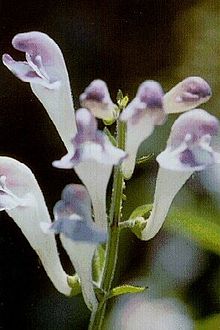- Scutellaria montana
-
Scutellaria montana 
Conservation status Scientific classification Kingdom: Plantae (unranked): Angiosperms (unranked): Eudicots (unranked): Asterids Order: Lamiales Family: Lamiaceae Genus: Scutellaria Species: S. montana Binomial name Scutellaria montana
Chapm.Scutellaria montana, commonly known as the Mountain Skullcap or Large-flowered Skullcap, is a federally threatened herbaceous perennial in the United States. This narrowly endemic species is found in the southeastern United States in parts of the Ridge and Valley and Cumberland Plateau Physiographic Provinces of Tennessee and Georgia.[1]
This perennial herb produces a single squared stem growing erect to a maximum height near half a meter. The hairy leaves have lance-shaped to nearly oval blades with wavy or serrated edges, measuring up to 8 centimeters long by 5 wide. The inflorescence is a raceme of blue and white flowers which may be up to 2.5 centimeters in length. Blooming occurs in May and June. The flowers are pollinated by bees.[2]
This plant grows in forests dominated by oak and pine trees, most often Quercus alba, Q. velutina, and/or Q. montana, and Pinus echinata or P. taeda. The soil is acidic, rocky, and shallow, sometimes as shallow as 3 centimeters. It is dry to somewhat moist in the habitat. Other plants in the habitat include Desmodium spp., Hexastylis spp., Chimaphila maculata, and Cornus florida.[2]
This plant was federally listed as an endangered species in 1986. When more populations were discovered, it was downlisted to threatened status in 2002.[1][2] It is still threatened by human activity such as logging, suburban development, and quarrying.[2]
References
- ^ a b Reclassification of Scutellaria montana (Large-Flowered Skullcap) From Endangered to Threatened Federal Register, 14 Jan 2002.
- ^ a b c d Scutellaria montana. The Nature Conservancy.
Categories:- NatureServe Vulnerable species
- Scutellaria
- Herbs
- Endangered flora of the United States
- Flora of Georgia (U.S. state)
- Flora of Tennessee
- Lamiaceae stubs
Wikimedia Foundation. 2010.

